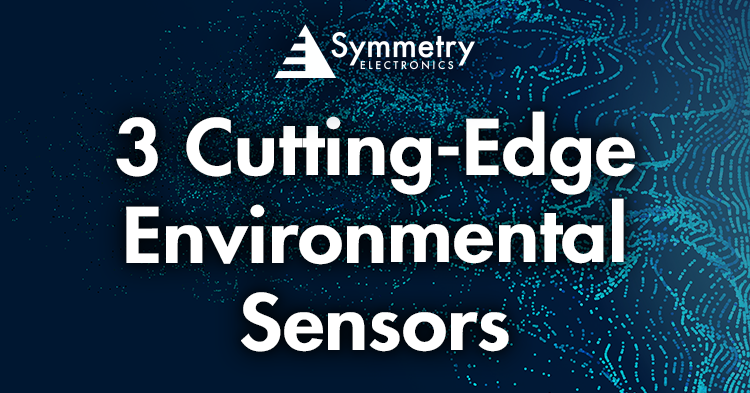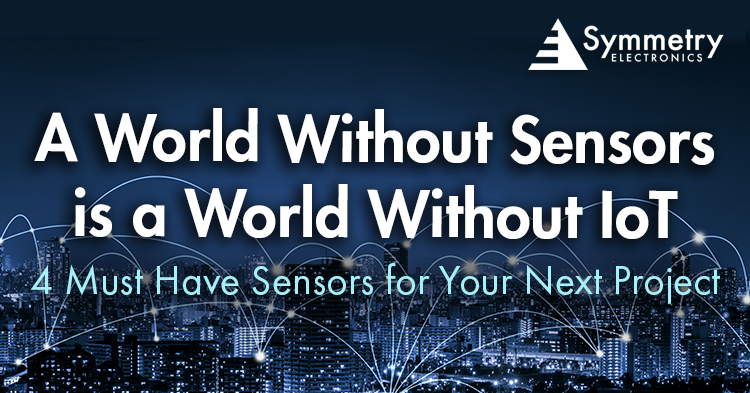- Home
- Symmetry Blog
- 3 Cutting-Edge Environmental Sensors
3 Cutting-Edge Environmental Sensors
About Jari Haiston

What Are Environmental Sensors?
An environmental sensor is a small device used to monitor, detect, and measure changes in its surroundings. The first environmental “sensors” date back to the 1800s and lack the traditional electronic definition of a device. Canaries were used by coal miners as the first type of advanced warning system to detect toxic gasses like carbon dioxide, carbon monoxide, and methane in mine shafts. Retired in the 1980s, technology surrounding environmental sensors has come a long way since avian notification systems. Let’s examine 3 cutting-edge environmental sensor solutions.
Carbon Dioxide (CO2) Sensors
The COVID-19 pandemic played a large part in the spike in the environmental sensor market. Consumers and businesses demanded technology that helped mitigate the spread of the virus. In fact, the global environmental sensor market share was $1.43 billion in 2020, and is projected to reach $3.86 billion by 2030, registering a CAGR of 9.7% from 2021 to 2030. Carbon Dioxide (CO2) sensors like Sensirion’s SCD40 can be utilized to measure and control increased concentrations of CO2 when groups of people are indoors. Not only has CO2 been linked to droplet transmission of COVID-19, but humans also naturally experience negative side effects when they encounter high levels of CO2. Studies have shown positive effects on productivity and health when CO2 concentrations in an environment are below 1000 ppm.
Key Features of Sensirion’s SCD40:
- High accuracy: ±(40 ppm + 5 %)
- Photoacoustic NDIR sensor technology PASens®
- Smallest form factor: 10.1 x 10.1 x 6.5 mm3
- Integrated temperature and humidity sensor
- Large output range: 0 ppm – 40’000 ppm
- High accuracy of ±(40 ppm + 5 %)
- Digital I2C interface
- Reflow solderable for cost-effective assembly
Particulate Matter (PM) Sensors
Particulate Matter (PM) refers to a mixture of airborne particles that can be harmful if inhaled. PM matter includes but is not limited to different types of dust, molds, pollen, tobacco smoke, and exhaust gases that lead to allergic reactions and respiratory diseases. PM sensors are crucial solutions that consumers, offices, and businesses can utilize to monitor and create safer air qualities indoors. Sensirion’s SPS30 uses laser scattering technology in combination with their contamination-resistance technology to enable healthier air quality.
Features of Sensirion’s SPS30:
- Lifetime of more than ten years
- Advanced particle size binning
- Superior precision in mass concentration and number concentration sensing
- Ideal solution for compact air quality or wall-mounted devices
- Fully calibrated digital output
- Small, ultra-slim package
Temperature and Humidity Sensors
Integrated in many smart home products, temperature/humidity sensors allow users to track the temperature and the amount of moisture content in indoor environments. Monitoring humidity and temperature in indoor environments can help prevent mold and enhance cost-savings surrounding heating/cooling. Sensirion’s SHT40 is a reliable temperature and humidity sensor that offers the best price-performance ratio on the market.
Key Features of Sensirion’s SHT40:
- Relative humidity accuracy: up to ±1.0 %RH
- Temperature accuracy: up to ±0.1 °C
- Supply voltage of 1.08 V-3.6 V
- Average current of 0.4 µA (at meas. rate 1 Hz)
- Fully functional in condensing environment
- Variable power heater
- NIST traceability
Environmental sensors provide consumers and businesses with a convenient way to control, monitor, and their surroundings. Environmental sensors are not limited to air quality monitoring. In fact, there is a broad range of environmental sensor types and an even wider range of applications. Environmental sensors are essential tools that help monitor weather phenomena, soil composition, water quality, radiation, atmospheric pressure, and much more.
Interesting in exploring more sensor solutions? Browse Symmetry Electronics’ extensive portfolio of IoT sensors.




